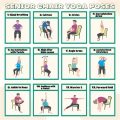Empowering Children Through Yoga: Developing Healthy Habits for Lifelong Wellness
Introduction
Yoga has long been recognized as a powerful tool for mental and physical well-being, but its benefits extend far beyond adults. For children, incorporating yoga into their daily routines can significantly shape healthy habits, promote emotional resilience, and foster a deeper connection between mind and body. In an era where children face unprecedented stress, sedentary lifestyles, and mental health challenges, yoga offers a holistic approach to nurturing healthy development.
This article explores the key concepts behind how yoga benefits children, providing a historical context, examining its current relevance, and offering practical applications and guidelines. Case studies, ethical considerations, and implementation strategies will also be discussed, with a focus on promoting inclusivity and accessibility for all children.
Key Concepts
Yoga, originating from ancient India, integrates physical postures (asanas), breathing exercises (pranayama), and mindfulness practices to promote holistic well-being. When applied to children, these principles encourage self-regulation, focus, and physical health. Below are the foundational components of yoga and how they relate to children’s healthy development:
- Mind-Body Connection: Yoga helps children develop body awareness and mindfulness, promoting better emotional regulation and reducing anxiety.
- Breath Control: Controlled breathing exercises teach children how to calm their minds, lower stress levels, and enhance concentration.
- Physical Strength & Flexibility: Asanas improve motor skills, posture, and overall physical health.
- Mindfulness and Focus: Yoga cultivates mindfulness, improving attention and focus, which can have positive effects on academic performance.
- Emotional Regulation: Regular practice supports emotional balance, teaching children to respond thoughtfully rather than react impulsively.
Historical Context
Yoga’s roots date back over 5,000 years in ancient India, where it was first practiced as a spiritual discipline. In recent decades, yoga has gained widespread popularity in the Western world for its therapeutic and wellness benefits. The adaptation of yoga for children is a relatively recent phenomenon, with the first structured programs emerging in the 1970s. By the early 21st century, yoga for children began to be incorporated into schools, healthcare, and community programs, responding to rising concerns about childhood obesity, stress, and emotional health.
The integration of yoga into children’s education was accelerated by growing research that highlighted its benefits. Studies have shown that children who practice yoga regularly exhibit lower levels of anxiety, improved self-esteem, and better overall physical health.
Current State Analysis
Today, yoga is practiced by children in schools, community centers, and even healthcare settings. However, despite its growing popularity, there remain significant challenges in ensuring equitable access to yoga for all children. Here’s an overview of the current landscape:
| Setting | Advantages | Challenges |
|---|---|---|
| Schools | Structured integration, reduces stress, improves focus, fosters positive school culture | Inconsistent access, lack of trained instructors, limited time in curriculum |
| Healthcare | Supports children with chronic conditions, mental health benefits | Not widely implemented, insurance coverage issues |
| Community Programs | Accessible to a broader audience, fosters community engagement | Funding, sustainability, outreach limitations |
Schools have been the most significant drivers of integrating yoga into children’s routines, often as part of physical education or wellness programs. However, disparities in program availability, especially in underserved communities, highlight the need for broader efforts to ensure all children can benefit from yoga.
Practical Applications
To make yoga accessible to children and encourage long-term healthy habits, it’s important to consider age-appropriate adaptations. Below are practical ways to introduce yoga in different settings:
- In Schools: Incorporating short yoga sessions as part of daily routines can enhance focus before class or during transitions. Breathing exercises and mindfulness techniques can be integrated into lessons to help with stress management.
- At Home: Parents can create family yoga routines that involve playful poses, making it an engaging and fun activity that also fosters family bonding.
- In Healthcare: For children with chronic conditions such as asthma or anxiety disorders, therapeutic yoga tailored to individual needs can be beneficial. Healthcare providers can work with trained yoga therapists to create supportive programs.
- In After-School Programs: Yoga can be an effective part of after-school programs, providing a healthy outlet for stress relief while promoting physical activity.
Case Studies
Several schools and organizations have successfully implemented yoga programs for children, yielding positive results. Here are two prominent examples:
| Program Name | Location | Outcome |
|---|---|---|
| Yoga in Schools Initiative | Los Angeles, CA | Improved students’ behavior, increased focus, and reduced anxiety in low-income school districts. |
| Mindful Schools Program | San Francisco, CA | Significant improvement in emotional regulation and attention span among elementary school students. |
Stakeholder Analysis
Several key stakeholders are involved in the promotion and implementation of yoga for children:
- Parents: As primary caregivers, parents play a crucial role in encouraging and supporting their children’s yoga practice at home.
- Educators: Teachers and school administrators can integrate yoga into daily routines to improve focus, reduce stress, and promote overall well-being.
- Healthcare Providers: Pediatricians, therapists, and other healthcare professionals can incorporate yoga as a complementary approach to managing chronic conditions or mental health issues in children.
- Community Leaders: Leaders in community centers or organizations can foster inclusive yoga programs that make wellness accessible to all children, regardless of socioeconomic background.
Implementation Guidelines
To successfully integrate yoga into children’s routines, the following guidelines should be considered:
- Training for Instructors: Teachers, caregivers, and healthcare professionals should undergo specialized training to teach yoga to children, ensuring age-appropriate techniques are used.
- Creating Safe Spaces: Yoga environments should foster inclusivity, safety, and comfort for children. This includes providing yoga mats, calming environments, and ensuring programs are non-competitive.
- Consistency: Regular, short sessions of yoga are more effective than infrequent, long practices. Schools, families, and community programs should aim for daily or weekly routines.
- Adaptability: Yoga programs should be flexible and adaptable to children with special needs or those facing physical limitations. Adaptive yoga can make the practice more inclusive.
Ethical Considerations
While yoga is widely beneficial, it’s essential to address the ethical concerns related to its implementation:
- Cultural Appropriation: Yoga originates from ancient Indian traditions, and its use in Western contexts must respect its cultural roots. Programs should honor the practice’s origins while adapting to children’s needs.
- Inclusivity: Yoga programs should be inclusive of all children, regardless of physical ability, socio-economic status, or background.
- Consent and Comfort: Children should never be forced to participate in yoga practices they find uncomfortable or distressing.
Limitations and Future Research
Despite its numerous benefits, there are limitations to the current research and application of yoga for children:
- Lack of Longitudinal Studies: Most studies on children’s yoga are short-term, and there is limited data on the long-term impact of regular yoga practice.
- Accessibility: Yoga programs may not be readily accessible to all children, particularly those in underserved communities. More efforts are needed to ensure inclusivity.
- Standardization of Programs: There is a lack of standardized guidelines on how yoga should be adapted for different age groups and settings. More research is needed to develop age-appropriate curricula.
Future research should focus on longitudinal studies that track the long-term effects of yoga on children’s mental, physical, and emotional development. Additionally, efforts should be made to create accessible, inclusive yoga programs that can be implemented in diverse settings.
Expert Commentary
Leading experts in the field of child development and yoga practitioners agree on the profound impact yoga can have on fostering healthy habits in children. As Dr. Sarah Thompson, a pediatric psychologist, explains, “Yoga provides children with tools to manage stress, enhance emotional intelligence, and develop physical resilience. It is a holistic approach to health that can support their development well into adulthood.”
Renowned yoga instructor Jane Miller adds, “We’re seeing more schools and communities embrace yoga, but there’s still a long way to go to make these programs universally accessible. We need to focus on training educators and creating inclusive environments where all children feel welcome to practice.”
In conclusion, yoga is an invaluable tool for helping children develop healthy habits that extend beyond physical fitness. By addressing the mind-body connection, promoting emotional regulation, and providing practical stress-management techniques, yoga equips children with lifelong skills that contribute to their overall well-being.








